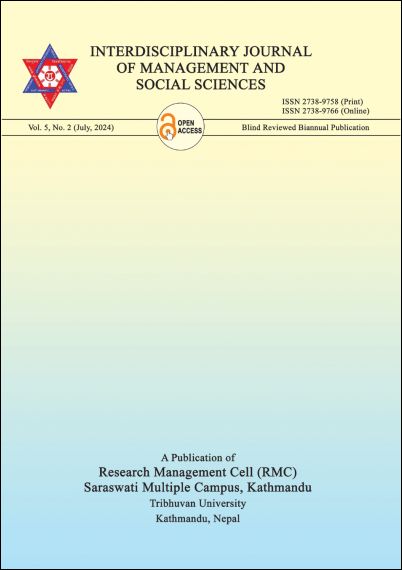Predicting the per-capita Income of Nepal with the help of the ARIMA model
DOI:
https://doi.org/10.3126/ijmss.v5i2.69448Keywords:
ARIMA model, autocorrelation, per capita income, predicting, stationeryAbstract
Understanding the root causes that affect any given issue, event, or variable in great detail is necessary to forecast it. This is true for estimating Nepal's per capita income. In Nepal, several factors, including employment, international commerce, industrialization, political stability, and productivity, have a significant impact on per capita income. As the nation's per capita income serves as a gauge for its economy, predicting per capita income is therefore not just laborious but also essential. The main objective of this research was to study the trend of per capita income of Nepal and to forecast it for the coming years. In this investigation Three possible ARIMA models were (2,1,0), (1,1,0) and (9,1,0) identified. Out of them based on different popular criteria ARIMA (9,1,0) model was found best-fitted model for the foresting of the per capita income of Nepal Among the three identified models R2 value of the (9,1,0) model was found greater compared to other models, different kinds of errors value were lesser compared to other models, so based on ARIMA model selection criteria (9,1,0) model was chosen as the best model for forecasting per capita income of Nepal. Five years of per capita income was forecasted by the fitted model. Forecasted per capita income for the years, 2023,2024,2025,2026, and 2027were1274.57,1429.25,1497.33,1587.67and1744.77 (In American dollars) respectively. IBM SPSS,19 version was used to identify the best ARIMA model and foresting per capita income of Nepal. secondary source of data was used in this study. Together 62 observed per capita income values recorded for different years were used to conduct this investigation. The accuracy of these predicted values, however, may be questioned because, frankly speaking, none of the components operate perfectly or in the desired direction; in this case, it might be wise to reevaluate a different forecasting model that would use more data to predict Nepal's per capita income. This is perhaps one of the paper's shortcomings.
Downloads
Downloads
Published
How to Cite
Issue
Section
License

This work is licensed under a Creative Commons Attribution-NonCommercial 4.0 International License.

